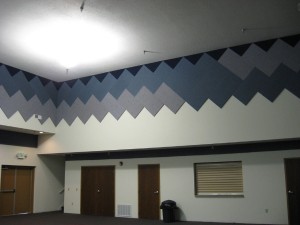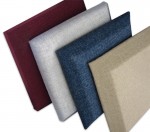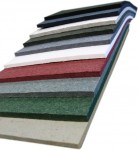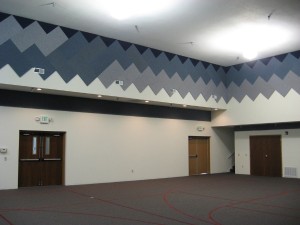Church Acoustics in Fellowship Halls
Fellowship Halls & Multi-Purpose Rooms
 Church acoustics in fellowship halls or multi-purpose rooms are some of the more frequent rooms that we are asked for recommendations for acoustical treatment. These rooms have a few very common similarities that are the reason for the need for acoustical wall panels or acoustical ceiling panels. These rooms are often quite large so that a large number of people can use the room at the same time. They also commonly have cinder block or sheetrock walls, a vinyl tile or linoleum floor. If carpet is present, it is almost always a very low pile, industrial carpet.
Church acoustics in fellowship halls or multi-purpose rooms are some of the more frequent rooms that we are asked for recommendations for acoustical treatment. These rooms have a few very common similarities that are the reason for the need for acoustical wall panels or acoustical ceiling panels. These rooms are often quite large so that a large number of people can use the room at the same time. They also commonly have cinder block or sheetrock walls, a vinyl tile or linoleum floor. If carpet is present, it is almost always a very low pile, industrial carpet.
How Many Panels Do I Need?
As far as echo and reverberation are concerned, the larger the room, the more square footage of acoustical treatment is needed to get the proper level noise control. Over the last few years, I have talked to thousands of people and a series of the same questions continues to be asked. “How many panels do I need?” This is a simple question that needs to be asked. The answer, however, is not as simple because rooms and the needs of rooms are always different. For simplicity’s sake, I know that rooms like this don’t need “recording studio” sound quality. They do need a noise control solution that takes the edge off so that when the room is filled with people the noise level is not ear splitting.
I’ve come up with a very simple equation to start with to answer the question above. This is not a guarantee or a necessity, but it is a generalization that I have had an extremely high success rate with. The square footage of paneling generally needed is found by multiplying the cubic volume of the room by 3%.
Height × Width × Depth × (.03) = Square Footage Needed For Room
What Kind of Treatment Is Best For Me?
Again, there is not a right or wrong answer to this question but there are some tendencies or trend that I do want to explain. Although there are hundreds of different kinds of acoustical treatments (including wall panels, ceiling panels, cloud baffles, diffusers, etc.), when it comes to treating a room like this, this extensive list of options is just about always reduced to two different types of panels. These are our Decorative Fabric Wrapped Fiberglass Panels and our Echo Eliminator Panels.
 The Fabric Wrapped Panels are custom made boards of fiberglass that are cut to size and wrapped with a decorative fabric. This option offers the most freedom of panel size and color which is very attractive to quiet a few people. The unfortunate part about the product is that because it is custom made and made by hand, it also comes with a higher price tag. This price tag often makes this option less attractive or simply not an option. Especially for a multi-purpose room where aesthetics isn’t as critical as it would be in a room like a sanctuary, our Echo Eliminator recycled cotton panels become much more attractive.
The Fabric Wrapped Panels are custom made boards of fiberglass that are cut to size and wrapped with a decorative fabric. This option offers the most freedom of panel size and color which is very attractive to quiet a few people. The unfortunate part about the product is that because it is custom made and made by hand, it also comes with a higher price tag. This price tag often makes this option less attractive or simply not an option. Especially for a multi-purpose room where aesthetics isn’t as critical as it would be in a room like a sanctuary, our Echo Eliminator recycled cotton panels become much more attractive.
 These acoustical panels are made from recycled cotton fiber and we offer them in nine different colors. They have an absorption rating that makes them an extremely efficient acoustical treatment. Because they are made from a recycled material, they are also very cost effective. They can be used as wall panels or ceiling panels and are most often glued directly to the structure with a construction adhesive and a contact adhesive. They are Class A fire rated, which is always important as well.
These acoustical panels are made from recycled cotton fiber and we offer them in nine different colors. They have an absorption rating that makes them an extremely efficient acoustical treatment. Because they are made from a recycled material, they are also very cost effective. They can be used as wall panels or ceiling panels and are most often glued directly to the structure with a construction adhesive and a contact adhesive. They are Class A fire rated, which is always important as well.
Where Should I Put These Panels?
My answer to this question almost always surprises people. For all practical purposes, to take the edge off of a room, the exact location of the acoustical wall panels or ceiling panels does not matter nearly as much as the square footage of panels introduced into the room. This leaves the end user with a lot of freedom to put the panels in a location where they will be most discreet.
The only two recommendations that I would like to pass along would be to space the panels out as evenly as possible throughout the room and, if the aesthetic works, space the panels out (rather than installing them one next to the other). Installing them throughout the room will give you the most even acoustical result and by spacing them apart, you will effectively increase the overall surface area of absorption and increase the performance of the panels as a whole.
Success Story
In December of 2006, Dennis contacted me about the multi-purpose room at the Bon Air Church of the Nazarene in Kokomo, Indiana. He was collecting information about products and treatments for the room. We talked briefly about the room and a few of the more popular products that he might be interested in and I put some samples and literature together and sent them to him. We spoke about the advantages and disadvantages of the products and he took the information to the committees and decision makers of the church.
Like all projects that I have done with houses of worship, the project was discussed and questions were asked, and ultimately the Echo Eliminator panels were chosen due to the low cost of the product and the high absorption numbers. Dennis sent me the measurements of the room and based on the size of the room and the surface that were present, I used the following equation to help him start to figure out how many panels the church was going to need.
The Room
This multipurpose room measures roughly 55′ × 65′ and has 20′ ceilings. The equation that I used to determine the square footage needed is listed above.
55′ × 65′ × 20′ = 71,500 (cubic feet) × .03 = 2,145 Square Feet of Panels
The Solution
 Based on the numbers from above, Dennis worked with church members to come up with a unique and decorative pattern for the cotton panels. The church purchased 64 panels of the Light Gray, 110 panels of the Pure Blue and 20 panels of the Navy Blue. They also purchased the cutting blade to cut the 2′ × 4′ panels down as needed.
Based on the numbers from above, Dennis worked with church members to come up with a unique and decorative pattern for the cotton panels. The church purchased 64 panels of the Light Gray, 110 panels of the Pure Blue and 20 panels of the Navy Blue. They also purchased the cutting blade to cut the 2′ × 4′ panels down as needed.
Most of our panels are adhered to the walls or ceiling of a room, but this type of installation is very permanent. Although most people are never going to want the echo problem to return, the idea of using a construction adhesive to install the cotton panels isn’t ideal. In this case, the installers used small nails to hang the panels. I do not know the exact details of how it was done, but they pulled it off very well.
Testimonial
Ted,
We have installed our sound panels. I have attached a picture to show you the pattern we chose. I will be sending the saw blade back to you tomorrow. We have seen a significant reduction in echo, and we especially can understand speech much clearer.We used nails to put up the panels. The color consistency was good, and they look good in this application. I would be interested in your thoughts.
Thanks,
Pastor Dennis R.





3 Comments
jason@NoiseKiller
Hey! Great blog, interesting and very helpful to help set up a sound proofed room.
Sound Proofing
Soundproofing a large room like a church makes such a difference,and its great to have the option of decorative panels. Although a church budget is likely to be low and not possible to have the more expensive panels, if you were to soundproof your home, its something worth considering. This article clearly explains the options available.
Mugwanya Susan
I ve come across your interior sound proof church through your testimonies and we would like to do the same here our church. How can we get more details ?
Pr. Steven and Susan
Kampala-Uganda